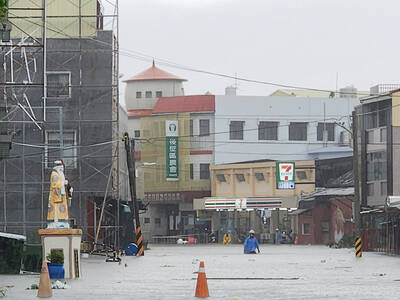As the US economy appears more than ever linked to the health of the housing market, analysts see no end to falling prices or recovery in the sector before next year.
After several years of a sizzling boom, housing prices in the US have fallen for the past year and a half, according to the closely watched S&P/Case-Shiller index. In May, prices fell a record 16 percent from a year ago.
But for the majority of analysts, the price decline still is not enough to put the sector back on track.
“Home prices in the US are likely to start to stabilize or touch bottom sometime in the first half of 2009,” former Federal Reserve chairman Alan Greenspan said on Thursday.
However, “prices could continue to drift lower through 2009 and beyond,” he said.
US Treasury Secretary Henry Paulson regularly repeats that the real-estate sector presently is the biggest danger for the US economy.
Late last month, Paulson warned that foreclosures and the number of existing homes for sale “are likely to remain substantially elevated this year and next and home prices are likely to decline further on a national basis.”
Several factors are at work.
Housing prices, although lower, are still far from reaching pre-boom levels, a recent survey by TD Bank Financial Group showed.
Today’s home prices are roughly at mid-2004 levels, while the S&P/Case-Shiller index shows they are still nominally 34 percent higher than 2002 prices.
“The correction isn’t over,” the TD Bank analysts said, adding that prices have further to fall, particularly in “cities such as Los Angeles, Las Vegas, and Miami which saw the largest price gains.”
The inventory of unsold homes on the market is so high — 11 months’ supply for existing homes, 10 for new homes — that sellers will have to lower their expectations before the market can return to normal, which analysts generally see as a five-month supply.
“The rising share of foreclosed homes in overall sales bodes negatively for home prices,” said Ethan Harris, chief US economist at Lehman Brothers, who sees prices falling between 25 percent and 30 percent in the correction phase of a cycle he sees ending late next year.
In fact, the owners of foreclosed homes are often banks, which today hold a sixth of the homes on the market, according to RealtyTrac, a real-estate industry data firm.
The banks have not been shy about disposing of these distressed assets. The Wall Street Journal this week reported on a house in Corona, California, that was sold for US$198,000 that was bought for US$450,000 in December 2006.
The fragile economy’s woes hardly inspire optimism.
“The light at the end of the tunnel is a faint and distant one. Further, the risks to this outlook weigh heavily on the downside, with the main risk being the potential for financial markets to unravel further,” said Celia Chen, director of housing economics at Moody’s Economy.com. “It will be well into 2009 before the market works off all the excesses accumulated during the housing boom.”

Rainfall is expected to become more widespread and persistent across central and southern Taiwan over the next few days, with the effects of the weather patterns becoming most prominent between last night and tomorrow, the Central Weather Administration (CWA) said yesterday. Independent meteorologist Daniel Wu (吳德榮) said that based on the latest forecast models of the combination of a low-pressure system and southwesterly winds, rainfall and flooding are expected to continue in central and southern Taiwan from today to Sunday. The CWA also warned of flash floods, thunder and lightning, and strong gusts in these areas, as well as landslides and fallen

WAITING GAME: The US has so far only offered a ‘best rate tariff,’ which officials assume is about 15 percent, the same as Japan, a person familiar with the matter said Taiwan and the US have completed “technical consultations” regarding tariffs and a finalized rate is expected to be released soon, Executive Yuan spokeswoman Michelle Lee (李慧芝) told a news conference yesterday, as a 90-day pause on US President Donald Trump’s “reciprocal” tariffs is set to expire today. The two countries have reached a “certain degree of consensus” on issues such as tariffs, nontariff trade barriers, trade facilitation, supply chain resilience and economic security, Lee said. They also discussed opportunities for cooperation, investment and procurement, she said. A joint statement is still being negotiated and would be released once the US government has made

SOUTH CHINA SEA? The Philippine president spoke of adding more classrooms and power plants, while skipping tensions with China over disputed areas Philippine President Ferdinand Marcos Jr yesterday blasted “useless and crumbling” flood control projects in a state of the nation address that focused on domestic issues after a months-long feud with his vice president. Addressing a joint session of congress after days of rain that left at least 31 dead, Marcos repeated his recent warning that the nation faced a climate change-driven “new normal,” while pledging to investigate publicly funded projects that had failed. “Let’s not pretend, the people know that these projects can breed corruption. Kickbacks ... for the boys,” he said, citing houses that were “swept away” by the floods. “Someone has

‘CRUDE’: The potential countermeasure is in response to South Africa renaming Taiwan’s representative offices and the insistence that it move out of Pretoria Taiwan is considering banning exports of semiconductors to South Africa after the latter unilaterally downgraded and changed the names of Taiwan’s two representative offices, the Ministry of Foreign Affairs (MOFA) said yesterday. On Monday last week, the South African Department of International Relations and Cooperation unilaterally released a statement saying that, as of April 1, the Taipei Liaison Offices in Pretoria and Cape Town had been renamed the “Taipei Commercial Office in Johannesburg” and the “Taipei Commercial Office in Cape Town.” Citing UN General Assembly Resolution 2758, it said that South Africa “recognizes the People’s Republic of China (PRC) as the sole